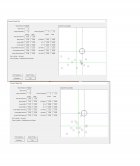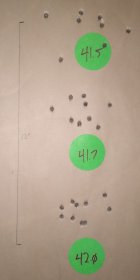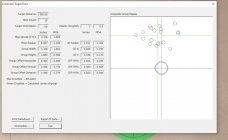disclaimer - I am a rookie F class shooter who scores low to mid 190's most matches, never "cleaned" a target. I am not a expert shooter nor a benchrest shooter. I doubt you will see me on stage at any national event any time soon and probably never will. I do this for fun and as a retirement hobby
A bit of background. With the recent primer supply situation I decided I need at least one rifle that used LRP's to practice with in order to conserve my SRP supply for matches only. I had a Shilen barrel in .260 Rem for a large shank Savage action with about 500 rounds down it sitting in the corner and the 6CM on my FTR gave up the ghost at around 1000 rounds, the throat looks like burned toast. So the 6CM went away and the Shilen got spun on. No action screw tuning has been done, all three screws are at 25 inch pounds.
I started last week with a rough load test using 140 SMK's and H4350. All the SMK's were seated at .025 from the lands for the initial test and at 42.0 gns 4 out of 5 shots went into the same hole with the 5th about 1/2 inch high. I wondered if the flyer could be caused by the case necks.
I proceeded to turn the necks on 25 cases to see what would happen. All cases were full length resized using different bushings to get .002 expansion after bullet seating. I normally prefer .003 but I did not have a bushing small enough to give me that on the turned necks and I wanted a apples to apples comparison. They were then loaded with 42.0 gns of H4350 checked on my A&D to be within .02 gns, seated .025 from the lands.
Wind conditions were mild about 4 - 7 mph, targets were at 300 yards and shot round robin. Fifteen rounds on each target. First shot was target 1, second was target 2 , third back to target 1 etc. After each ten shots the barrels were allowed to cool and the next string was started with the opposite load han the last. Here are the results using Ontarget analysis. The turned necks are the top target, the bottom unturned necks.
First thing I noticed was the horizontal stringing on the turned necks and the 2 "high" flyers on the unturned neck group. Since the groups were shot round robin I do not think wind could have caused the horizontal stringing. Nor do I think it was shooter error because if you look at the horizontal and vertical offsets for both groups they are almost identical which leads me to believe my POA was consistent.
My takeaway is that the turned necks may solve the flyer problems. I have some new bushings in the mail to play with neck tension some more and will play with seating depths to reduce or eliminate the horizontals. I am hopeful that with a bit of work I can get this barrel down to a decent sub .5 MOA shooter.
Just posted this for the fun of it, but feel free to comment and offer suggestions
A bit of background. With the recent primer supply situation I decided I need at least one rifle that used LRP's to practice with in order to conserve my SRP supply for matches only. I had a Shilen barrel in .260 Rem for a large shank Savage action with about 500 rounds down it sitting in the corner and the 6CM on my FTR gave up the ghost at around 1000 rounds, the throat looks like burned toast. So the 6CM went away and the Shilen got spun on. No action screw tuning has been done, all three screws are at 25 inch pounds.
I started last week with a rough load test using 140 SMK's and H4350. All the SMK's were seated at .025 from the lands for the initial test and at 42.0 gns 4 out of 5 shots went into the same hole with the 5th about 1/2 inch high. I wondered if the flyer could be caused by the case necks.
I proceeded to turn the necks on 25 cases to see what would happen. All cases were full length resized using different bushings to get .002 expansion after bullet seating. I normally prefer .003 but I did not have a bushing small enough to give me that on the turned necks and I wanted a apples to apples comparison. They were then loaded with 42.0 gns of H4350 checked on my A&D to be within .02 gns, seated .025 from the lands.
Wind conditions were mild about 4 - 7 mph, targets were at 300 yards and shot round robin. Fifteen rounds on each target. First shot was target 1, second was target 2 , third back to target 1 etc. After each ten shots the barrels were allowed to cool and the next string was started with the opposite load han the last. Here are the results using Ontarget analysis. The turned necks are the top target, the bottom unturned necks.
First thing I noticed was the horizontal stringing on the turned necks and the 2 "high" flyers on the unturned neck group. Since the groups were shot round robin I do not think wind could have caused the horizontal stringing. Nor do I think it was shooter error because if you look at the horizontal and vertical offsets for both groups they are almost identical which leads me to believe my POA was consistent.
My takeaway is that the turned necks may solve the flyer problems. I have some new bushings in the mail to play with neck tension some more and will play with seating depths to reduce or eliminate the horizontals. I am hopeful that with a bit of work I can get this barrel down to a decent sub .5 MOA shooter.
Just posted this for the fun of it, but feel free to comment and offer suggestions
Attachments
Last edited:













